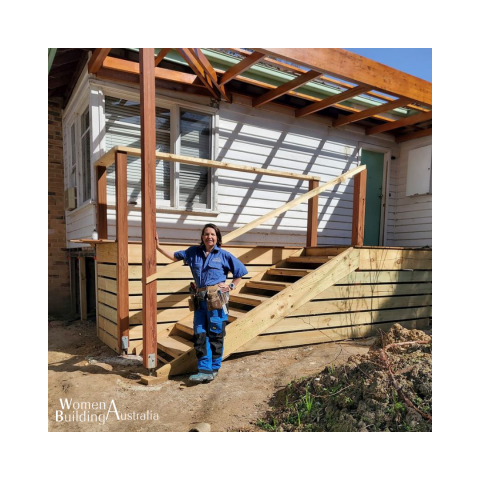
‘They couldn’t hire me because they had to build a separate toilet’

By Marcelle Bagu, Founder of Marcelle’s Carpentry and Building for The Deal magazine in the Australian.
I started my carpentry apprenticeship in 2004 at the age of 32. My first day in a commercial site lunch room was an eye-opener. An older man was reading the business magazine BRW, another guy was shuffling through a lewd magazine, one was doing a crossword and a young electrician was reading a Charles Dickens novel. On residential sites my co-workers would read The Age and listen to Triple J.
At my initial placement at Tribeca apartments in East Melbourne, I was one of two female tradespeople on a site of 500 guys. Back then, women in trades were rare. My male colleagues seemed most concerned that I would try to get them to change their language or what they discussed at lunch or want them to put away any girlie magazines lying on the tables.
I was just glad to be there: it was the rarest of opportunities. I was a ministerial adviser in Victoria’s Bracks government, with no building experience, and I was looking for an apprenticeship in carpentry. Getting hired by Multiplex Constructions 17 years ago was like finding a pink Argyle diamond on the street.
The regular reaction to my arrival on sites during my apprenticeship was quaint curiosity – the concreters ran down the stairwell to peer around the corner and exclaim: “There’s a girl on site!” Across my four-year apprenticeship I was seconded to various contractors to learn my trade and was usually treated like a younger sister, accepted as part of the family.
Of course I experienced resentment and suspicion: what was I trying to prove; what was my agenda; was I here to find a husband? When I phoned for job opportunities, it was common for the receptionist to ask if I was ringing on behalf of my brother or husband. I was told they could not hire me because they would have to provide another lavatory on site. At times I felt isolated and questioned if I was learning enough but, overall, my experience was very positive.
The latest Australian Bureau of Statistics Labour Force Survey data on women in the construction industry made me reflect on why numbers are still so low. When I started my apprenticeship in 2004, women made up 11 per cent of the construction workforce and less than 1 per cent were in trades. Now the total is 13 per cent and trades comprise 2 per cent.
The main growth in numbers has been in managerial and professional positions such as site managers, engineers and architects. There also has been an impressive increase in female machinery operators and drivers – from zero in May 2011 to 2677, or 3 per cent of workers in those occupations. Even so, one has to ask: are trades still seen as jobs for men? Are they not prioritised in schools as a career option? Do women finish their apprenticeship, then leave after a few years? Or are parts of our industry simply not providing an entry point for women?
A career in building and construction offers so many opportunities for women, but it was only when I started my own business that I realised the possibilities for growth and further education. During the global financial crisis I was made redundant from my commercial carpentry position and it spurred me to go out on my own.
Female-owned and run trades businesses are in great demand, and in a very competitive industry it is a clear point of difference.
As a registered residential builder I have achieved a confidence and self-reliance I never thought possible. I have a wonderful team of male and female tradespeople, and we respect each other’s skills and get along well.
I am still on the tools, which I thoroughly enjoy, yet I can step back and manage projects if working becomes too arduous in the future.
I can take on several residential renovations and extensions, or simply do one at a time. It’s in my hands.
Trades offer the opportunity to work for yourself and set your own hours and pay rates; to have control over your career; to choose your clients; your specialisations and the location of your jobs.
People sometimes ask why I became an apprentice in my 30s. I come from a family of public servants so I was expected to go to university and forge a white-collar career. I settled on politics and gained a bachelor of arts, a graduate diploma in industrial and employee relations, and a diploma of journalism from RMIT.
I jostled my way up the ladder and landed a role as a ministerial adviser but I realised my enthusiasm for politics as a field of study was nothing like the day-to-day of parliament and political life. No one in my family had ever done a trade, and moving from a minister’s office to a building site looked like a complete car crash, but I have made a success of it.
There is a great deal of support for women in trades, from the federal government’s 500 gateway service places and in-training support services; and mentoring, trade days and workshops from groups including Women Onsite, Tradeswomen Australia, Women Building Australia, and Supporting and Linking Tradeswomen.

